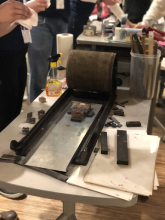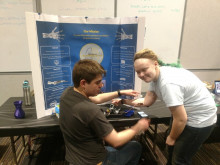Happenings from the Shapiro Design Lab.
Lab Notes

Posts in Lab Notes
Showing 121 - 130 of 208 items
•
- Kayla Williams
Design Lab Student Developer Kayla Williams reflects on learning about the Django web framework.
•
- Hallee Thompson
Design Lab Resident Hallee Thompson reflects on her own history with accessibility and its importance in many different architectural spaces.
•
- Hallee Thompson
Design Lab Resident Hallee Thompson reflects on her year as an Open Accessibility Resident.
•
- Xiaoqian Niu
Design Lab Resident Sophie Niu discusses a workshop she attended on Sketch.
•
- Anamaria Cuza
Design Lab Intern Ana Cuza reflects on a talk from Dr. Kristie Dotson about combining research and activism.
•
- Anamaria Cuza
Design Lab Intern Ana Cuza discusses her work looking at applying machine learning to ecological studies of animal populations.
•
- Michael Cory Lenard
Unlike some of my peers at the Design Lab and in the School of Information, I am not by default a very visually-oriented person when it comes to thinking, learning, or expressing myself. In order to engage with this perspective a bit more, I decided to attend a Visual Thinking Seminar facilitated by a UMSI alumnus, Katie McCurdy. Specifically, the seminar was about “drawing for meaning” -- drawing as a thinking aid, a problem solving strategy, and a communication style. This was referred to as a “functional” drawing, as opposed to an artistic drawing.

- Savina Sahgal
For the third year in a row, the Shapiro Design Lab and the Library Student Engagement Ambassadors hosted a Valentine’s Day event with the Design Lab’s printing press. Students and staff from across the campus came to Shapiro Undergraduate Library the day before Valentine’s Day to make cards for their loved ones and drink hot chocolate.

- Kelly Hovinga
On February 7th, the Shapiro Design Lab and the University of Michigan Prosthetics Club participated in the Emerson School Science Fair. Emerson School is a private K-8 institution with a dedicated staff and over 150 students. The theme for the science fair was "Problem Solvers: Using the Design Thinking Process to Find Solutions for Everyday Problems." Of the 150 students, the majority of them participated in the Fair. Projects ranged from 3rd grade mechanical card dealers, to a student in the 8th grade that created an AI that mapped cities for disaster relief. The Science Fair stretched from the school gym, through the halls, and into the large auditorium. The large auditorium is where the Shapiro Design Lab found itself tabling.
•
- Gloria Myunghyun Chun
What brought you to the Shapiro Design Lab?
I actually came to the SDL in search for a new job after my work study job ended. I thought that I would make the most of losing my work study and find something that had less mundane activities and more interesting work. With a Mechanical Engineering degree, I thought I could perhaps apply my knowledge outside of the classroom and project groups. I came across the SDL application by word and applied! After an interview with Justin, I was hired! That was the Fall of 2017, and I've been having a blast here ever since.
I actually came to the SDL in search for a new job after my work study job ended. I thought that I would make the most of losing my work study and find something that had less mundane activities and more interesting work. With a Mechanical Engineering degree, I thought I could perhaps apply my knowledge outside of the classroom and project groups. I came across the SDL application by word and applied! After an interview with Justin, I was hired! That was the Fall of 2017, and I've been having a blast here ever since.